GALLERY 1 (2D)
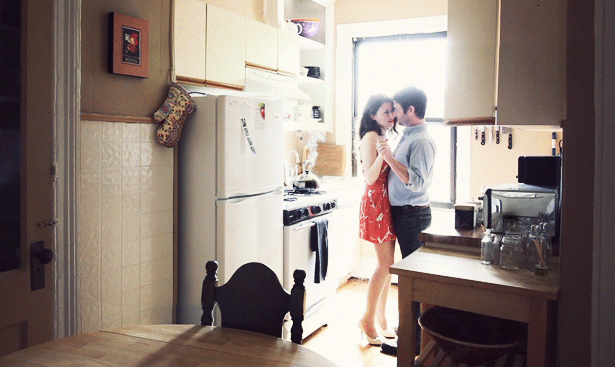 |
My presentation was not related to paintings in any way. The topic was not anything from the 17th or 18th century; not even anything from the 19th or 20th century… but, something as fresh, and cutting edge as it gets from February 2011. Before going on with anything, I’d like to thank Christopher for letting me do a presentation on this, as even I’m not sure these things can be considered as “art” in its classical sense! I was talking about cinemagraphs. As you can see, these are still photos with simply one aspect of the photo moving. In some of these cinemagraphs there’s only some hair motion, or dress motion, or maybe only the eyes will come to life. One photo taken of a cafe in NYC looks like a normal photo until a few seconds later a taxi drives past. At the end of the day they look a bit like the magical newspaper from Harry Potter. Nowadays everybody is creating cinemagraphs, but the first ones to do it (and still, the best ones are coming from them) were New York City-based photographer Jamie Beck, and a webdesigner with a background in video and motion graphics called Kevin Burg. They complement each other really well: one is coming from modern art, while the other is responsible for the technology going on behind the scenes. “We began seriously creating them during fashion week this past February. We feel there are many exciting applications for this type of moving image. There's movement in everything, and by capturing that, plus the great things about a still photograph, you get to experience what a video has to offer; without the time commitment a video requires. There's something magical about a still photograph -- a captured moment in time -- that can simultaneously exist outside the fraction of a second the shutter captures.” – Says Jamie. The creators – can we say artists? – started off with looping sequenced still shots, but soon they moved towards isolated, however, much more fluid motion. This way, part of a still photo is “un-frozen” somehow for the viewers. Editing and creating these cinemagraphs is a totally manual process: Kevin has to face and overcome new difficulties each time they are working on something. Therefore editing one picture can take from 3-4 hours up to even a whole day. There are people who criticize cinemagraphs for not being a new thing at all. Critics claim that animated gifs have been around since 1987, and there is nothing artistic in cinemagraphs with only giving a new name to the same old thing. The real answer, however, is even there are animated pictures all around the internet, nobody has ever done such moving, still photographs before. Nobody says that Van Gogh or Ebuterne stole the concept of painting – they both turned around a well-known procedure using their own style and methods. My two pennies worth on the whole thing is that I’m personally really delighted when art and technology comes together. This hasn’t always been the case: even in the 18th century people from art and technology wholeheartedly opposed one another. This fact also has some personal relations to me, as being a musician on one hand and an IT guy on the other, I really like when these aspects collaborate and make something great together. George
|
 Jeanne Hébuterne Self Portrait |
Jeanne Hébuterne was a French artist born at the end of the nineteenth century. She was also known as a frequent subject and common-law wife of painter Amadeo Modigliani. She wanted to pursue a career in the arts and with a talent of drawing; she chose to study at the Académie Colarossi in Paris which was founded by the Italian sculptor Filippo Colarossi. Jeanne was always described as a gentle, shy and delicate woman and this clearly reflects on her relationship with Modigliani. They were introduced to each other by Russian sculptor Chana Orloff in the spring of 1917. The young lady and the mischievous artist fell deeply in love in no time. The couple often did portraits of each other. Also, she may have appeared to be just passively posing for Modi, in truth she seemed to be absorbing his technique and was fascinated by the theatrical method of his painting. Jeanne was so devoted to Modi that she committed suicide a day after her beloved husband died of tuberculoses meningitis on 24 January 1920. Her epitaph reads “devoted companion to the extreme sacrifice” (Compagna devota fino all’ estremo sacrifizio in Italian). The fact that she was a very talented artist, her contemporaries failed to noticed as she was in the shadow of her notorious husband. She tried to lead a definite creative life of her own so she played the violin, and was fond of sewing unusual fashion designs. After her death, Jeanne Hébuterne’s papers were scattered, her artworks and possessions secretly guarded by her brother, André Hébuterne. Surviving family members and friends would not collaborate with biographers and scholars who later attempted to piece together the facts of Jeanne’s relationship with Modigliani and to define her place in Montparnasse. It took more than thirty years before an art scholar convinced the Hébuterne heirs to allow public access to Jeanne’s artwork. In October 2000, her works were featured at a major Modigliani exhibition in Venice, Italy. Altogether 60 drawings and half a dozen paintings were displayed. Of her works, very little is known. This self-portrait was produced in 1916. The colours, in my opinion, clearly express her artistic colours. Compared to Modi’s dark and brownish shades, she used several blues and pinkish colours to make her painting lively. In her works, she portraits herself as a very feminine and delicate figure, which most probably she would have been without Modigliani. Eszter
|
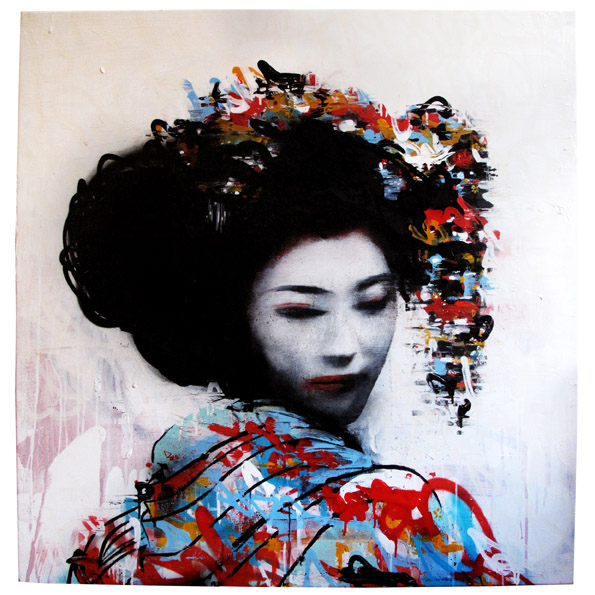 Hush
'Looking West',
2010 |
Hush is a contemporary artist, who is present in prestigious galleries having solo shows and exhibitions, but his works can also be found on the streets of London or New York. Originally Hush studied graphic design and illustration at Newcastle School of Art and Design. During his art studies he visited Asia and America, where he immersed himself in the diversity of cultures. These experiences had a huge impact on his art, especially the years he spent in Japan. In his works he infuses many genres within contemporary art, which creates an exciting outcome. His techniques are complex, as he wants to mimic years of tags and graffitis painted on each other. In his interpretation every mark or tag left on the walls is evidence of another's action or creative expression, despite its gradual degradation over time. As over the years tags go on tag or any other paintings on the walls, this accidental layering creates something beautiful. He wants to achieve this multilayered texture which is characteristic of the transient quality of street art. While doing a piece he is not afraid of any technique which results in adding something to the painting. His highly evolved mixed-media pieces are produced as a result of painting, screen printing, spay-painting, using stencils, throwing paint on the canvas or including old graphic novels. Controversy is also an important word if you want to describe Hush's works: he also uses traditional art forms along with very recent street art techniques. The themes are also opposing: the artist presents contemporary depictions of traditional portrait and figurative imagery. The central focus of Hush's work is images of iconic and pop art renditions of the female form, particularly of the geisha and the anime manga. On the painting 'Looking West' tags instead of flowers or the kimono represent the Western imagery while in the focus of the painting it is the portrait of a geisha which stands for traditional Japanese values. The artist often tries to depict this cross-culturalism in his other works too. As Hush himself said his art represents a change in Japan "the escape from the constraints of traditions, the contrasts between old and new, the past meeting the future and the fusion of Eastern and Western culture" Anna Zsofi Hush @ Shooting Gallery http://www.youtube.com/watch?v=EL-6bhkDMG8&list=FL9ZQX5b_nIpAp4lJV_qIBMA&index=6
|
 Jim Jones (1971 - ) Untitled – ca. 2010 - 2011 Pencil on paper, 29.7 cm x 42 cm Property of the artist |
Jim Jones is a contemporary artist born in Johnstown, Pennsylvania in 1971 in a family of four children. He attended elementary and secondary school in the city, then moved to New York, where he currently resides. The artist is not too well-known since it was recently when he started showing his works to the public, therefore, little is known about his artistic history. However, he claims to be going through different periods rather than sticking to a certain artistic style or method. Initially, he created pictures influenced by Andy Warhol and Roy Lichtenstein, but collages, wire sculptures and Xerox pieces also can be found in his repertoire along with pencil based drawings such as the one showcased here. The artist states that his works never have any meaning beyond what can be seen and, instead of messaging the viewer the pieces reflect the ongoing personality changes of Jones. It is notable that here he drew on low quality paper and used an abstract, though still realistic way of expression., and shows the undeniable influence of the famous expressionist and art nouveau artist Egon Schiele. This work, depicting a human face, gathers all the characteristics of the current works of Jones: the dry atmosphere, the narrow colour palette and the thin, sensitive and fragile lines. It seems like he would not like to give any concrete information about what can be seen, that is why the parts of the face are hardly recognisable. The picture does not have a precisely planned structure and is rather spontaneous. In addition, Jones is neither trying to tell a story, nor to express opinion, but to cast light on his inner characteristics in order to bring out an emotional response from the viewer. This feature makes his picture more psychological and more likely to fit in the category of expressionism. Bence
|
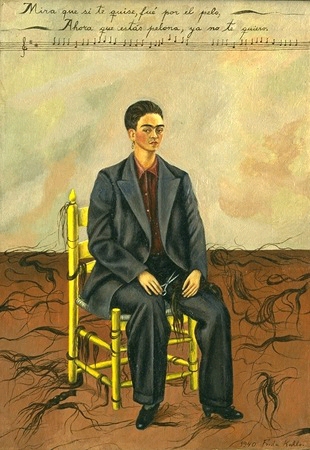 Frida Kahlo Self-Portrait with Cropped Hair |
During my presentation, I dedicated a lot of time to Frida Kahlo’s biography. The reason for this is that knowing the happenings in the artist’s life is the key to understand her artwork. So... she was born in 1907 in Mexico, in the “Blue House” in Coyoacán. It played an important role in her life as she spent her childhood there and returned there from time to time throughout her life. Her accident in 1925 was a turning point for her. What happened is that a trolley car crashed into the school bus she was also sitting on. She sustained several injuries: her pelvic pone broke, she had a damaged spinal column, and many other injuries. These came only top of her polio-affected leg which she was born with. There were doubts whether she would survive and she was told by the doctors that there is no chance that she could carry a child to full term. During the time when she was bedridden, she started to take painting seriously and her early genial works were created at this time. In two years she recovered to the extent that she could live a largely normal life. She had a sort of “on-and-off relationship” with both the Communist Party and with her later husband, Diego Rivera who she was introduced to in 1927 and married in 1929. Frida desperately wanted to have children, but she was never able to carry her foetus. As a young painter, she lived in the shadow of Diego, but later she became recognized as well, she spent years in the United States, mostly in New York and she had exhibitions in Paris as well. However, she was homesick and wanted to escape back to her homeland. Her emotional crises and poor health condition came back again and again. She died of pneumonia in 1954. Self-Portrait with Cropped Hair is the painting I have chosen to make my presentation about. The technique is oil on canvas. As for the size, it is 40x28 cm. It can be found in the Museum of Modern Art in New York. She painted it after divorcing Rivera in 1940. The strange thing about this picture is that it does not really fit in her self-portraits as she usually depicted herself with long hair and in colorful clothes, but on this one she has short hair and she is wearing a men’s suit. The locks of fresh-cut hair symbolize the enstrangement from Rivera. It is obvious that she cut it all of a sudden as the various-length locks are everywhere in the room. Her cut hair looks as it sort of vivifyes and sneaks around like a snake or just floats as if it was in the water. Her limbs are quite long and head is small, though in reality, she looks quite the opposite. Her body posture is quite open, her face is calm that suggests that she is ready for a change, in other words to establish her independent life as an artist. The suit she has on might be Rivera’s and hints that she is capable of redefining his art in her own terms. The background is quite neutral. The radiation of the picture is quite surrealist. Kahlo wrote the lyrics of a Mexican folk song on the painting. In general, she was influenced by Mexican Renaissance and Mexican realist portrait painters. Obviously her husband’s muralist artwork also had a big effect on the way she thought and painted. In my opinion, Frida Kahlo’s artwork and life is a strength-giving “story” of a little, handicapped woman and it can be exemplary both for painters and for us, laymen. Judit |
 Georges Seurat (1859-1891) A Sunday Afternoon on the Island of La Grande Jatte – 1884, 1884-86, painted border 1888/89 Oil on canvas, 207.6 cm x 308 cm Art Institute of Chicago |
Georges Seurat (December 2, 1859 – March 29, 1891) was a French Post-Impressionist painter and draftsman born into a bourgeois family in Paris, France. He established the notion of Post-Impressionism as he was the first one to use the technique of pointillism although he would rather refer to it as divisionism. Pointillism is the technique of adopting tiny brushstrokes in the form of dots in order to accumulate a great variety of colors and tones. Seurat firmly believed that this optical mixture, which – from a given distance – blend optically, produced a far greater intensity and luminosity of color than any mixture of pigments. First he devoted himself to the art of black and white, the contrast of dark and light masses. He started using the pointillism technique on his first great composition Une Baignade ŕ Asničres (Bathers at Asničres) in 1884 and although it was rejected by the Salon jury, Seurat hung it at an exhibition where he struck up a great friendship with other artists including Paul Signac. He began working on the A Sunday Afternoon on the Island of La Grande Jatte in 1884, after he was finished by 1885 he reworked it in 1885-86 and lastly added a painted border presumably sometime during 1888-89, which according to him would become the visual transition between its interior and the frame. And so he carefully studied the landscape and the crowd of the public park on the island. He went there every day for four months to gather the necessary “information” for his work and for further details he had models pose for him in his studio. As preparation he made 28 drawings, 28 panels and 3 larger canvases before actually painting the La Grande Jatte. He played both the playwright and the director of this painting as he arranged the scene and picked out the characters which at last ended in 3 dogs, 8 boats, 48 people and a monkey. The characters are of every kind including soldiers, boaters, the fashionably and casually dressed, the young and the old, families, couples and single men and women. Seurat ignored the individualities; he was only intrigued by the elegant forms of the people and the crowd. And although Seurat captured a lot of dynamic activities the feeling we get from the painting is an odd stillness and calmness. Everything is balanced and tidy, we receive the impression of an overly controlled world. There are many interpretations of the painting: no one can surely know the real reason behind the painting's orderly fashion but the influence of it is certainly great. Frederick Bartlett, who was appointed trustee of the Art Institute of Chicago, purchased the La Grande Jatte in 1924; today it still can be viewed there. Ramona
Post-Impressionism – From Van Gogh to Gauguin, by John Rewald, Museum of Modern Art; 3rd edition - January 1979 Seurat and the making of La Grande Jatte, The Art Institute of Chicago – 2004 |
 Botond Kuti (1984 - ) The Last Dance, 2008 Oil on canvas - 145 cm x 135 cm Property of the artist |
Botond Kuti is a Transylvanian young artist, born in 1984 in Marosvásárhely (Tg. Mures), Romania. Growing up in the heart of Transylvania, in a town called Szováta (Sovata), influenced by his father’s paintings, he soon turned to art himself. Given this artistic and creative background, he was determined to become a painter by the age of 14. From 1999 to 2003 Botond was a scholarship student in the Department of Painting at Palló Imre High School of Fine Arts in Székelyudvarhely (Odorheiu Secuiesc). In 2003 he was accepted to the Department of Painting at the University of Art and Design in Kolozsvár (Cluj Napoca). He successfully completed his studies at BA level in 2007, and Master of Arts level by the year of 2009. After completing his university studies, he moved back to his home town for a short while. He worked as a graphic designer for a local art magazine. He found this to be really good experiment and challenge visually, but felt that this job distracted him from creating his own original paintings. He moved back to Kolozsvár, where he currently lives. Botond is an independent, free-lance painter, with works showcased at a number of prestigious exhibitions and galleries. In July 2011 father and son had an exhibition in Brühl, Germany. His works so far have been exhibited in Szováta, Marosvásárhely, Kolozsvár, Pécs, Budapest and London (’Art of Living’ – international art exhibition, Knighstbride, London). „Stepping out of the shadow’ of accomplished painter father, Dénes Kuti, Botond’s artistic road lead him through a number of influences and themes. His constant search and experimenting has resulted in a number of artistic phases. The initial landscapes and stills were followed by the attempt to depict the passing of time. Later on his ‘Wreck Nudes’ series captured the attention of a wider audience. Botond turned to abstracts, recently experimenting with new techniques that cross the line between two and three-dimensional art. The Last Dance (2008) reflects how the regional and cultural influences were very much a determining factor in his work as the women are wearing traditional széki dresses. It can be said that this painting evokes past emotions, recalls the beauty of the past. Tradition is very much alive, vivid, which is enforced by the variety and tenseness of the colors. However this dizzying dance, with its never-ending movement and blend of colors recalls an apocalyptic atmosphere. In this sense, the title is justified; the dance macabre is what we see. Zsófi |
 Vincent Van Gogh (1853-1890) Vincent’s Bedroom in Arles (1888) Oil on canvas, 72x90cm, Arles |
This is one of Van Gogh’s best known paintings, and the author himself held it as one of his favourites. We can observe a very familiar subject, but its perspective is very unusual and the striking colours also make it special. Van Gogh was very pleased with his painting; he even wrote letters about it to his family. Talking about the style, bright and bold use of colours was typical of him that time, especially yellow, which was his favourite. The work is kind of unrealistic, the portrayal of the bedroom is odd, but certainly very exciting. One of the aspects that makes the painting unique is that objects in the room are skewed towards the viewer; the author often rejected the conventional perspective. Furthermore, the picure-within-the-picture motif also makes the work easily recognizable: the artist depicted other examples of his own work within the painting. Maybe the reason why he became such a huge artist after his death is that his works show an effort to explain either his struggle against madness or his comprehension of the spiritual essence of man and nature. Marton |
 Ferdinand Georg Waldmüller (1793–1865) Sitting Girl in White Sateen Robe (aka Sitzendes Mädchen in weißem Atlaskleid) (c. 1839) Oil on Canvas Belvedere Museum in Vienna |
The Biedermeier era was characterized by the sentimentalism of the Central European middle-class in thehistorical period between 1815 (the end of the Napoleonic Wars), and 1848, the year of the European revolutions. Biedermeier painters had the intention to approach the world from a non-political, sentimentalist aspect. Ferdinand Georg Waldmüller was one of the most remarkable Austrian painters of the Biedermeier period. Waldmüller was born in January 15th 1793 in Vienna. He studied at the Academy of Fine Arts Vienna. He made a living out of painting portraits at this time. He lived in Bratislava, and then in 1811 he was asked to teach arts for the children of Count Gyulay in Croatia. After three years he returned to Vienna, where he became concerned with copying the works of old masters. He painted portraits, genre subjects, and still-life. Waldmüller died in August 23rd 1865 in Hinterbrühl, Austria. He was criticized for not following the traditional methods of the Biedermeier artists. In spite of this, Waldmüller’s techniques were revolutionary for his time as he insisted on depicting what he saw in a realistic way. His stubbornness in terms of his views on painting made him one of the most influential artists of the Biedermeier period. The Sitting Girl in White Sateen Robe (1839) exemplifies Waldmüller’s portrait-painting methods in a perfect way. In this period, portraits were ordered by nobles and royalties in order to trumpet abroad how perfect they are. This painting is a counterexample of these portraits. The girl depicted in this portrait has a facial expression that suggests that she is bored or unhappy. The painting’s composition is triangular-based. The girl’s right arm, her forehead, and her left elbow form a triangle which forms the painting’s center. I chose this work because the Sitting Girl in White Sateen Robe is the perfect counterexample of the typical 19th century portraits, and the excellent example of Waldmüller’s unconventional portrays at the same time. Péter Sources: http://www.wga.hu/bio_m/w/waldmull/biograph.html
|
 Andy Warhol (1928-1987) Golden Marilyn, 1962 Silkscreen ink on synthetic polymer paint on canvas, 6’11 1 / 4” x 57” (211.4x144.7 cm). Gift to Philip Johnson. Andy Warhol Foundation for the Visual Arts/ Artists Rights Society, New York
|
Andy Warhol is one of the most famous painters of modern art: he is the father of commercial art and the ‘Pope of Pop’. He was born in 1928, in Pittsburgh, Pennsylvania. His parents immigrated to the US from a small Slovakian town called Mikó in the beginning of the 20th century before Andy was born. His childhood was quite difficult due to the fact that he had a nervous system disease called chorea, which causes involuntary movements. At that time it was believed to be a complication of scarlet fever so he had to visit many doctors and had to spend nearly all of his childhood in bed. Although he became an outcast in school and bonded with his mother, Warhol describes this period as a very influential one in the development of his personality, skill-set and preferences. He started to collect pictures of celebrities and listened to the radio while he was drawing in his bed. He showed an early artistic talent and studied commercial art at Carnegie Institute of Technology in Pittsburgh. In 1949 he moved to New York, where he started his career as a commercial artist and an illustrator. In the 1950s he was known by his whimsical ink drawings of shoes created in a blotted ink style. This period was also important because he held exhibitions in the Bodley Gallery, although his first solo pop-art exhibition was held in the Stable Gallery. These were important events where the famous Campbell’s soup cans, Coca-Cola bottles and the Marilyn paintings were introduced. During the 1960s he continued to paint iconic American products and iconic American people, such as Elvis Presley, Muhammad Ali, Elizabeth Taylor. He founded “The Factory” which was a studio and gathered around himself a wide range of musicians, artists, movie stars and underground celebrities. This was the period of silkscreen method which is similar in style to the industrial paintings, different colors represent different moods. In this method a woven mesh is used to support an ink-blocking stencil and a roller is moved across the stencil to force the ink into the printing surface. 1968 was a very important year for Warhol, because a feminist called Valerie Solanas shot him and a critic, Mario Amaya at the Factory. Solanas was a member of the Factory crew, she appeared in some films of Warhol, too. Her reason to kill Warhol was the excessive influence he had on her life. Unfortunately Andy was wounded heavily and doctors had to open his chest and give his heart a massage to stimulate its movement. Although he survived, the physical and spiritual effects haunted him until he died. The 1970s were a quieter decade for Warhol because he started rounding up celebrities to portray them. During that time he painted Mick Jagger, Bridget Bardot, Liza Minelli, John Lennon and Diana Ross. He founded the Interview magazine and published a book called The Philosophy of Andy Warhol in which he expresses the following idea: “ Making money is art, and working is art, and good business is the best art.” At that time he was criticized for being a business artist, capitulating to consumerism and embracing the market culture. The reviews of his paintings called them superficial, commercial, with no depth or indication of the significance of the subjects. He also started creating time capsules, which were large cardboard boxes and he put newspapers, airplane tickets, pictures and sometimes even food to them. The nearly 600 boxes can be found in the Andy Warhol Museum, in New York. Warhol also created album covers for Michael Jackson, The Rolling Stones and for Aretha Franklin, too. He also made some highly artistic movies, for example in the one called Sleep, a man is sleeping for six hours.. His other famous films were Chelsea Girls, and Lonesome Cowboys, for example. Andy Warhol died in 1987 of complications following a gallbladder operation. His funeral was a big event, we know that he was buried in a black cashmere suit with the Bible and a red rose in his hands. Paige Powell throw a copy of the Interview magazine, an Interview T-shirt and some Estée Lauder perfume into Warhol’s grave. In his will, he wanted to create a foundation to foster innovative artists, so the Andy Warhol Foundation was made to help other artists. The painting called the Gold Marilyn was made in 1962, in the year Marilyn Monroe died. The work of art was created on the basis of a still for the movie Niagara made by Gene Korman. It has a very bright gold coloured background symbolizing Hollywood glamour and fame. Monroe’s face is in the centre of the picture, but later Warhol created many versions of this one, so he undermined the uniqueness of the famous actress. The painting represents the cult of celebrity and by duplicating the images in his future works he described Monroe as a consumer product. By creating many copies Warhol burned the line between art and commodity. Other works based on the Gold Marilyn include The Green Marilyn and Marilyn Dyptich. Dia |
GALLERY 2 (3D)
 Agnes Denes Wheatfield - A Confrontation Battery Park Landfill, downtown Manhattan 2 acres of wheat planted & harvested in summer 1982 |
Agnes Denes (1931, Budapest) is a Hungarian born pioneer of the environmental art movement and conceptual art. Her work addresses social, environmental, and cultural issues – and is often monumental in scale. Her works are not temporary, moreover, they try to leave their mark and deliver a universal and timeless message for future generations. Wheatfield – A Confrontation (1982) was an outdoor ’living sculpture’ in downtown New York, Lower Manhattan. The enormous amount of wheat was planted on top of the Battery Park Landfill. The wheat field’s 2-acres area is a spot from where one can see the Statue of Liberty, Wall Street and once the Twin Towers. It seems that the landfill was the suitable spot for an installation that is meant to symbolize a major clash between culture and nature; the field of gold contrasted to the grid-like steel construction of the modern metropolis, and the contradiction of fertile land at hand and presence of world famine. The actual set up of the organic piece of art required a year-long hard work and effort. The landfill was created by the debris from the construction of the World Trade Center. Denes had two assistants to help her carry out the necessary preparations, complemented with a varying number of volunteers. In order to plant the wheat, litter and rocks needed to be removed. Furthermore, the soil was to be weeded and an irrigation system to be set up. All the hard work paid off in the end. They were able to harvest 1000 pounds of healthy golden wheat. The fact that $158 worth of wheat was cultivated on a land valued at $4.5 billion is contradiction in itself. The actual function and image attached to that piece of land in Lower Manhattan is where the contradiction and anomaly lies. Denes urges us to ‘re-think our personal values, consider misplaced priorities, and to realize that life is in danger.’ „Introduce a leisurely wheat field into an island of achievement-craze, culture, and decadence. Confront a highly efficient, rich complex where time is money and money rules. Pit the congestion of the city of competence, sophistication, and crime against open fields and the unspoiled farmlands....The everlasting against the forever changing. Culture against grassroots....Simplicity versus shrewd knowing. What we already know against all that we have yet to learn.” http://greenmuseum.org/content/artist_index/artist_id-63.html |
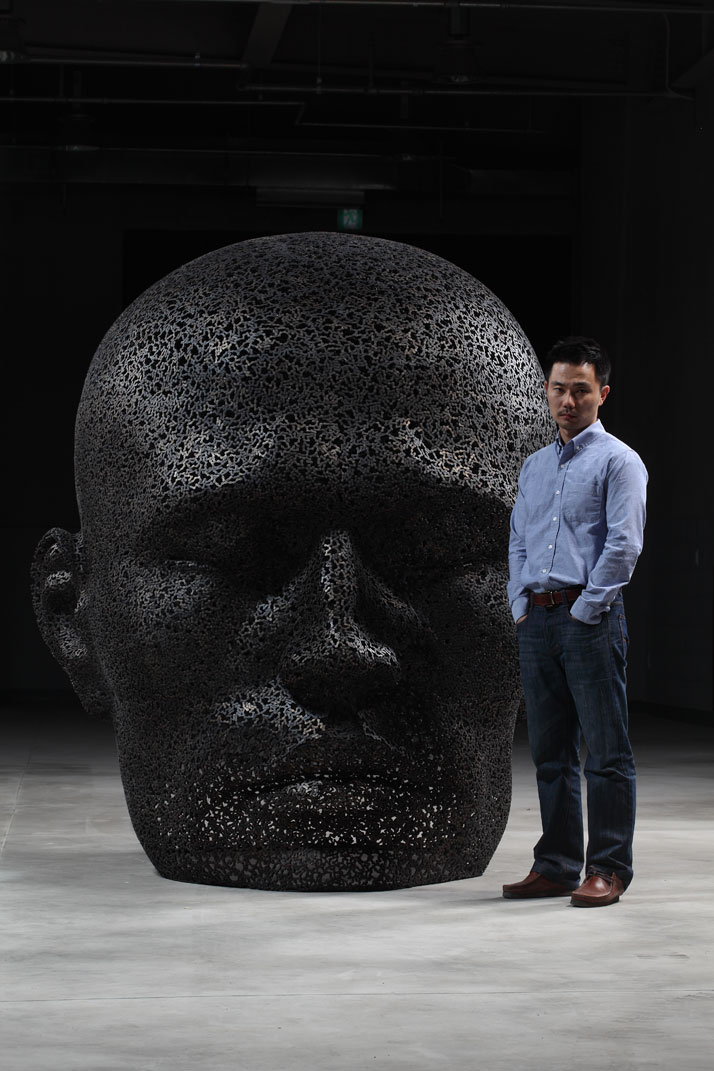 |
Seo Young Deok’s chain sculptures The human body and its formation lie at the core of the work of this Korean artist, who is preoccupied with the stories told through the human figure. His solo exhibition 'Dystopia' took place at the INSA/Arko Art Centre in Seoul 2011 and showed his nude sculptures made in welded metal chain links piece by piece. Seo Young Deok presented a number of nude sculptures, some lying on the ground, some hung on the walls. He used welded metal chains in order to model them, linking them piece-by-piece. What Seo Young Deok's sculptures capture is the anxieties of the modern human and especially the anxieties of the younger generation. Thus, his work has a strong sociological meaning that reflects upon the fragmented world we live in. Some of his pieces lie on the ground and some of their parts are fragmented as if they have been broken. The artist, in that sense, tries to capture the struggle of his subjects. The body is the form of a temple where the artist draws spiritual inspiration. Therefore, by breaking it down into pieces and sewing it back in circumstances of stress, this clearly indicates his position on the man of today and his state of mind. That, in combination with the industrial materials (plain and bicycle chains) implies a statement in terms of this distress evident in the human forms as a comment on today’s industrial and the manufactured world. One might also go as far as to say that the fact that he is using chain and therefore a form of linkage is an attempt to present the natural form as one with the manmade and the mechanized. In other words, technology and the industrial are life today. Seo forms the bodies with fragments of chains which appear to be cells. He shows expressions at random rather than in arrangement, but on the other hand he seems to set up an intense formative search. His human bodies are firm on the whole. However, they are helplessly melting down, they are not solid. They are empty inside. It says that they are infected by something and its transfer so rapidly occurs that the entire bodies become rotten, although they look undisturbed from outside. Seo’s stories are summarized as a large head-sculpture placed on the empty ground. Like the deep silence of a monk, it is firmly placed, throwing away and hiding all the unnecessary sentiments. Seo deserves to be applauded for his young devotion, woven stitch by stitch. David
Video: http://www.youtube.com/watch?v=bMlXjCVX7Dk |
 Dömsödi Levente & Rácz Dániel |
Dömsödi Levente & Rácz Dániel – ‘Byciclemonster’ Levente is originally a painter, he usually does wall-painting and decoration in a very unique style, for commission and for his own fun. Dániel is a lamp-maker with great technical and mechanical knowledge. They started to collaborate and soon enough the combination of their skills resulted in creating pieces of furniture, interior design elements and all kinds of other design - and artworks. Their favorite hobby is to visit metal landfills and clear-outs for collecting material they will use later on but also just for fun. Their main motto is that “anything can be made from anything”. This artwork of theirs is a kind-of ‘bicyclemonster’. An advertising company delivered it to the brand Zwack Unicum, and it was installed at its drinking and music bars during various Hungarian summer festivals, such as VOLT, Balaton Sound or Sziget. The requirement for the commission was that it has to be somehow based on a bicycle, and that it could be pedaled, and that something would happen while pedaling. It should have machine characteristics, built in a steam-punk style. The main idea of steam-punk style is to employ appropriate materials (such as polished brass, iron, wood, and leather) with design elements and craftsmanship consistent with the Victorian era. The bicycle-machine does not have any new technology; they have simply put the parts together mostly from metal waste, so it was very cheap to produce, though it took two weeks to build it up, decorate it, and make it work. Dániel did the mechanics and Levente did the painting, style and design. They have very unique ideas as well as technical and mechanical perspective. Anna Zsófia |
 |
The Berlin Holocaust Memorial is located one block South to the Brandenburg Gate. It is made of 2711 massive rectangular stones on a sloping stretch of land which are arranged on a plot of land between East and West Berlin. Each stone has a unique shape and size as a tribute to the victims of Holocaust. There are no inscriptions, religious symbols or any kind of decoration on them which provides a gloomy atmosphere and partly this is the reason why they are compared to coffins or tombstones. There is a labyrinth between the stone slabs which symbolizes the loss and disorientation of Jews. You can get lost easily in it, but the stones are not that high so you can be spotted from everywhere. The idea of building something like this developed in the late 80s, that was when the citizens’ initiative began. The jury was made up of representatives from field of art, architecture, politics and there were a few celebrities as well. The only hint that was given to the competitors is the price range they had to operate with. They approved Peter Eisenman’s plans in 1999, so that was when the actual work could start. It opened in 2005. There were several controversies about it, quarrels whether it is too abstract or not and if it captures the horrors of Nazi death camps or not. To overcome these, a “Place of Information” was attached to it underground where people can gain historical information. In my opinion the most interesting in the underground part is the Room of Names which presents the biographies of the victims and is constantly updated. Its goal is to restore the dignity and identity of the victims in a way. Interesting fact is that the stones in the memorial are covered with a special substance to prevent graffiti. As I mentioned before, this architectural masterpiece is highly controversial. I am definitely on the PRO side, I like it a lot. I am keen on it for not being that straightforward. In my opinion, for that is the House of Terror for instance only a few streets away. However, it is quite thought-provoking and it became an integral part of Berlin. German people will never be able to completely digest the massacre that is always associated with their nation due to their WWII leader, Hitler. I take this memorial also as part of their struggle in order to get over the horrors. Judit |
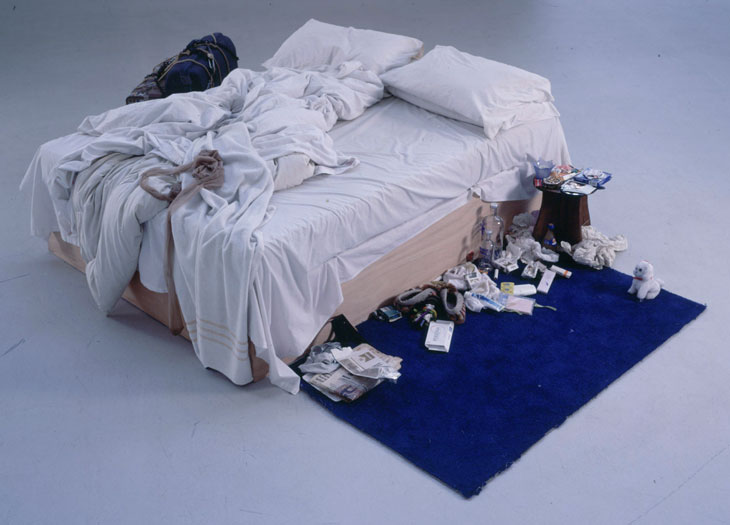 Tracey Emin |
Tracey Emin was born in London in 1963. She graduated with a first in fine art at Maidstone College of Art in 1986, and was awarded an MA in painting by the Royal College of Art in 1989. Her first solo exhibition, at White Cube, London, in 1994, was entitled 'My Major Retrospective'. Her solo exhibitions have included Stockholm, Brussels, Istanbul, Helsinki, Paris and Berlin, and she was nominated for the 1999 Turner Prize. She didn't win, but Charles Saatchi paid Ł150,000 for her installation. ’My Bed’ was displayed as part of the first exhibition when the Saatchi Gallery opened its new premises at County Hall, London. Saatchi also installed the bed in a dedicated room in his own home. Probably, ’My Bed’, created in 1998, is her most discussed installation. There was considerable media furore about this, particularly as the sheets of the bed were stained yellow, and the floor surrounding it had items from her room such as condoms, empty cigarette packets, a pair of knickers with menstrual stains and other detritus including a pair of slippers. The bed was presented as it had been when she had stayed in it for several days feeling suicidal because of relationship difficulties. Tracey shows us her own bed, in all its embarrassing glory. The scene is the bloody aftermath of a nervous breakdown. By presenting her bed as art, Tracey Emin shares her most personal space, revealing she’s as insecure and imperfect as the rest of the world. Some see poetry in the titles of her work. They include: You Forgot to Kiss My Soul; Every Part of Me Is Bleeding; My Cunt is Wet With Fear; and I Need Art Like I Need God. In conclusion, Tracey Emin might not be the kind of artist your granny would like. Her autobiographical style of work is all about exposing the kind of things about herself that most people would be too ashamed to reveal. Some say that she is a con-artist, others say that she is genuinely talented. Well, personally I think she is a bit like Marmite – you either hate it or love it. Eszter |
 McDougall Melbourne Recital Centre and MTC Theatre |
The Melbourne Recital Centre is Melbourne's second largest auditorium for classical music . It was opened in 2009, as part of the Melbourne Recital Centre and MTC Theatre complex located in Southbank. It was designed by a famous company, ARM (Ashton Raggatt McDougall). The Hall has two auditoriums: the Elizabeth Murdoch Hall and The Salon. The Hall has over 1000 seats and it has a shape similar to a shoe-box because while designing the creators wanted to build a room with as good acoustics as possible. To reach the best outcome, they asked many musicians and looked at many older buidings to collect all the useful ideas and to leave out the less good ones. The Recital Hall has beautiful walls covered with timber to make the acoustics even greater. The mass of the timber lining has been designed to achieve strong bass response within the hall. This enhanced low frequency response provides a musically rich timbre to music presented in the hall, particularly for cello and bass. The most critical area in the design of a recital hall is the platform acoustics. The surfaces surrounding the platform must promote the delicate and immediate communication between ensemble players. Elisabeth Murdoch Hall has a unique, stepped ceiling surrounding the platform that has been carefully designed to provide strong acoustic reflections to support musicians hearing themselves, and to assist with ensemble with other players. I chose this building because it is a mix of traditions and new technologies, and it is serious and funny in one. It is also really beautiful at night when the different colors of neon lights on the building are spreading their lights. Diana |
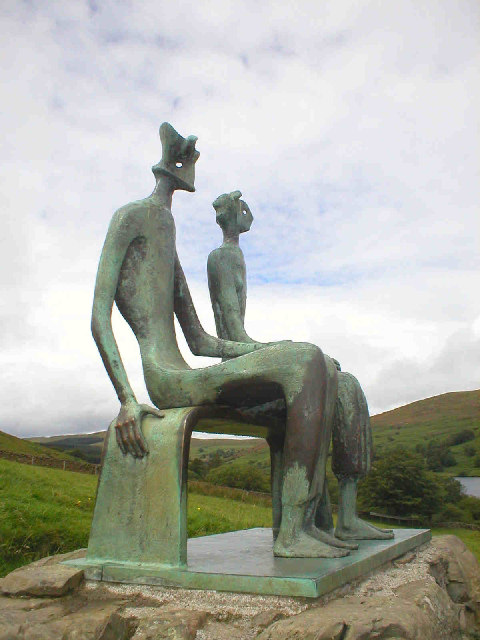 Henry S. Moore
King and Queen 1952-3, cast
1957 |
Henry Spencer Moore was one of the most influential English sculptors. He was born as the seventh child to a working class family in July 1898 in Castleford, Yorkshire. After his return from the World War, he attended classes at the Leeds School of Art. In 1921, he won a scholarship to the Royal College of Art in London. His works were typically semi-abstract bronze sculptures. His main themes were the mother-child relationship and the female body. He was also obsessed with depicting reclining figures due to the inspiration of the Pre-Columbian Mesoamerican stone statue called Chac-Mool. Henry Moore died on 31 August 1986 in Much Hadham, Hertfordshire. King and Queen is a typical Moore-sculpture. It depicts a sitting couple. The theme of this sculpture is not obvious at all. Some interpretation suggests that the theme of this sculpture is the conception of the monarch. This sculpture was ambiguous even for Moore. When he was asked about it, he said: “The ’King and Queen’ is rather strange. Like many of my sculptures, I can’t explain exactly how it evolved. Anything can start me off on a sculpture idea, and in this case it was playing with a small piece of modelling wax”. King and Queen is a mixture of naturalistic elements, for example the hands and feet, and the more abstract or primitive features, such as the heads. Moore claimed that he made this sculpture because back then he was reading fabulous stories about queens and princesses to his daughter. Peter Sources: http://en.wikipedia.org/wiki/Henry_Moore www.visual-arts-cork.com/sculpture/henry-moore.htm+king+and+queen+moore&cd=32&hl=hu&ct=clnk&gl=hu&client=opera |
 Claes Oldenburg & Coosje van Bruggen Spoonbridge & Cherry (1985 – 1988) Stainless steel and aluminum painted with polyurethane enamel (9 x 15.7 x 4.1 m) Minneapolis Sculpture Garden, Walker Art Center, Minneapolis |
Claes Oldenburg is a contemporary sculptor born in 1929 in Stockholm but lived mostly in Chicago, then in New York City. He is known as a significant artist of the pop art movement and among his works are soft versions of common household objects. He had a fruiting co-operation with his second wife Coosje van Bruggen for decades, during which they created enormous sized sculptures of such ordinary things as ice cream, a baseball bat or a bicycle. However, these huge sculptures not only enlarged replicas: either their angle, their location or their position makes them even more special. One of such crafts is the Spoonbridge and Cherry, which is situated in Minneapolis, as it is the centre piece of the Minneapolis Sculpture Garden. It was installed in 1988 and is made of aluminium and steel. The work has a function over its artistic purpose, since there is a fountain embedded in the stem of the cherry. Oldenburg initially planned only the spoon bridge, but his wife found it too passive and plain, so she coined the idea of a cherry on the top of the spoon. There is a big contrast between not only the spoon and the cherry but also between the whole craft and its environment, since the park is a green place, and putting such an alien object in the middle of it sounds awkward, but in practice it somehow really works. The contradiction between the nature and the forms of the two object is also notable since a spoon is something artificial and man-made while the cherry is nature grown and it can be seen that the spoon-part is rather more-or-less linear in contrast with the sphere-like shape of the cherry. There is a balance within the whole craft concerning colour (the plain grey opposed to the harsh red), and the vertical-horizontal proportion is also close to equal with the thin, but long part of the spoon balanced by the upwards and thicker spoonhead and cherry. These features, it’s naivety and pure effect-mechanism make this piece so attracting but if someone does not go beyond philosophy and just stops thinking while looking at it, it is still amusing. Bence |
 Tadao Ando |
Tadao Ando was born in 1941 in Osaka, Japan. He was never a fan of studying, he visited Kyoto and Nara several times to witness how a building is built and experience the act of architecture. He preferred studying on site instead of going to school every day. Between 1962 and 1969 he traveled to the United States, Europe and Africa a number of times. He learnt about their culture, architecture, history and techniques, and as a result he got a unique blend of style from these rich cultures. He then established his own architecture firm, Tadao Ando Architects & Associates in Osaka and he gained an incredible reputation with his distinctive style. He was already a visiting professor at several prestigious universities and won dozens of awards in his lifetime so far. He was mostly influenced by Modernism and he was fascinated with light. He is known to be using light as a creative element of his buildings. A very beautiful example is the Church of the Light which was built in 1989 in Osaka. As he said himself “light is the origin of all being. Light gives, with each moment, new form to being and new interrelationships to things, and architecture condenses light to its most concise being. The creation of space in architecture is simply the condensation and purification of the power of light.” Another material he uses repeatedly is concrete, which for some people may seem as a dense an oppressive material but with the right combination of light and even water, he manages to build something truly appreciable. Although his most remarkable works are his religious buildings he designed a number of conference halls and buildings with other functions as well. The Awaji Yumebutai is on the island of Awaji in Japan in the town of Yumebutai. This large prjoect was finished by 2000 and consists of many separate parts. It has a hotel, chapel, international conference center, restaurant, terracing flower garden, water garden, plaza that is animated through light and shadow and sounds of running water, a green house, and an outdoor theater. Hyakudanen garden is a terraced flowerbed of 100 4.5m2 sections along the side of a mountain on which this project was built. Each flowerbed is planted with different colored flowers or plants and commemorates the victims of the Hanshin earthquake that shook the Kobe region in 1995. It serves as a memorial and also a garden, although it doesn't reflect the calm and relaxed feelings of a garden someone would walk through. It has the Japanese perfectionism that orders everything to be geometrically flawless. Tadao Ando surely works within the Japanese boundaries but also tries to break out from them a little, by placing the flowerbeds in a way that seen from different angles reveals different messages he wants to get through. With the right mixture of silky, smooth concrete, rough stone, sea shells, translucent and transparent glass, water and light we get something new and interesting. Tadao Ando is still one of the most influential architects of our time. He is still working today and hopefully will for a very long time. Ramona |
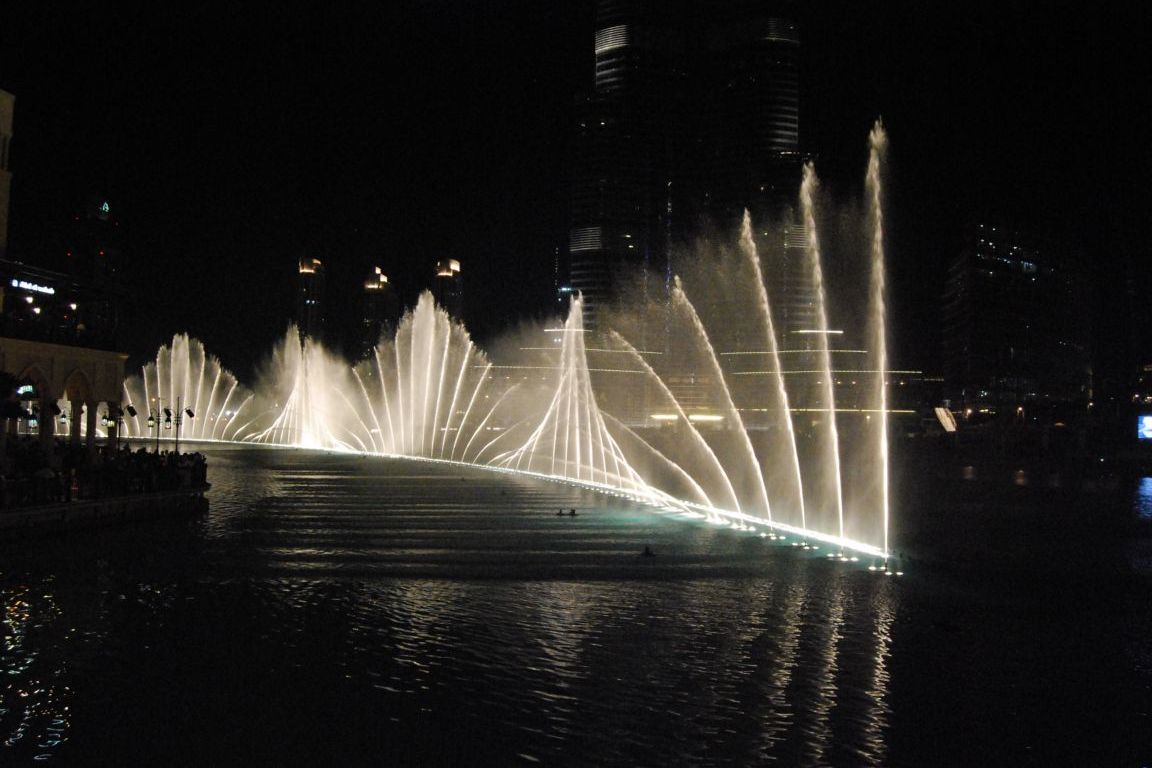 Wet Design |
The Dubai Fountain is the largest dancing fountain in the world. By dancing a kind of water show is meant, which is carefully choreographed to match different kinds of musical hits from all over the world. The attraction is made complete by a breathtaking lights element as well, to give a full, unforgettable and overwhelming experience to those who are fortunate (or rich) enough to see it. The length of a show depends on the length of the actual song or soundtrack which is played: usually one “sitting” is around 4-5 minutes. This doesn’t seem to be too long, however, it’s on every half an hour – and the repertoire is thick enough to entertain you for several days. Both classical Arabic music and popular world hits are played: to be honest, seeing a show choreographed on Michael Jackson’s Thriller or Barbra Streisand’s Time to Say Goodbye was much closer to me than the traditional Arabic songs. The fountain is situated in the park between the world’s biggest shopping mall, the Dubai Mall, and the world’s tallest building, Burj Khalifa. All in all, Arab people like all the fuss. The fountain has been built by the California-based WET Design, who already have experience in setting up huge fountains in Las Vegas, supervised by the national building company, Emaar properties. The fountain is huge by its numbers as well. The fountain is almost 300 metres long, and shoots water up to 150 metres high, which is the equivalent of the height of a 50-story building. Four different types of shooters are installed into the system: water robots, which can make the water seemingly dance; shooters, which shoot water up into the air; super shooters, which can shoot water up to 100 metres high; and extreme shooters, which shoot water up to an amazing 150 metres. The extreme shooters need time to generate enough pressure, so they are only used once or twice during a show; when shooting water up high, they make a loud noise, releasing all the pressure. The fountain in between Dubai Mall and Burj Khalifa is definitely a must-see when you get to Dubai. One thing is for sure: if you’re lucky enough to see it, the water show together with the lights and music is an experience you’ll never forget. George |